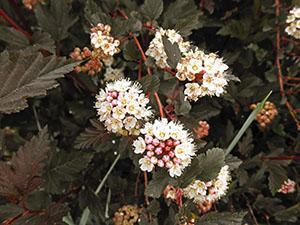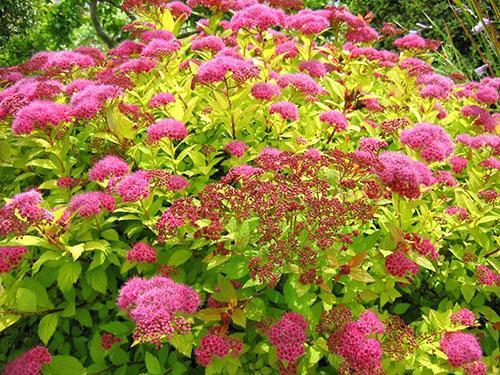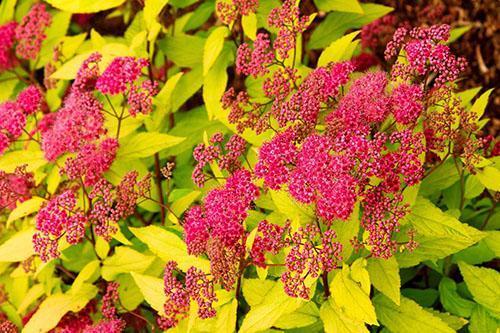Photo and description of popular varieties of spirea
 Spireas Are deciduous ornamental shrubs, cultivated and growing wild in almost all regions of the Northern Hemisphere. Thanks to the efforts of breeders, the range of natural species has been significantly expanded, and today gardeners can choose from almost a hundred amazingly beautiful and dissimilar species.
Spireas Are deciduous ornamental shrubs, cultivated and growing wild in almost all regions of the Northern Hemisphere. Thanks to the efforts of breeders, the range of natural species has been significantly expanded, and today gardeners can choose from almost a hundred amazingly beautiful and dissimilar species.
You can find a shrub to your liking by studying photos and descriptions of popular varieties of spirea, which include plants:
- with different colors of inflorescences and leaves;
- fairly large and dwarf crown sizes;
- spring and summer flowering periods.
With all the diversity of the world of spirits, all types of shrubs are unpretentious, and in the third year they are ready to please gardeners with the first inflorescences.
Spirea Golden Princess (Spiraea japonica Golden Princess)

Golden Princess is a spirea with a wide rounded crown, only 0.6 meters high and twice as large in diameter. A characteristic feature of this shrub, which blooms from mid-summer to the onset of autumn, is its decorative foliage, which, depending on the season, changes color from yellow-green to deep yellow and even orange.
Densely covering erect shoots, oblong leaves do not exceed 7 cm in length and are serrated along the edges. Against such a bright background, the corymbose pink or reddish inflorescences of the Golden Princess spirea about 5 cm in diameter look great. The shrub tolerates the winter of the middle zone well, does not need painstaking care and special soil mixtures, but shows the best flowering in good lighting.
Spirea Gold Flame (Spiraea japonica Goldflame)

The spirea Gold Flame, which blooms profusely in summer, is not so surprising with its richly pink paniculate or thyroid inflorescences, as with unusually bright jagged foliage, which, when it appears, has a purple hue, then turns light yellow, and by autumn turns into a real orange-yellow flame with carmine flashes. Thanks to this feature, the variety got its name.
A shrub about 0.6-0.8 meters high in the middle zone blooms in the second decade of June, and the last flowers wither only by mid-August. The culture grows rather slowly, giving only 10 cm of growth per year. In garden plantings, Spirea Gold Flame can be used to decorate a flower garden and as a basis for a low hedge... The shrub is not a hassle if planted in loose soil, receives regular watering, and has enough sunlight without which the yellow foliage dims or turns green.
Spirea Macrophylla (Spiraea japonica Macrophylla)

Macrophila, which belongs to the group of summer blooming shrubs, is valuable not for pink inflorescences, but for variegated foliage, the color of which on the tops of the shoots becomes more saturated and creates the main decorative effect. The wrinkled leaves of this species, which are unusually large for a spirea, are excised along the edge and reach 20 cm in length and 10 cm in width. In the spring they have a purple or purple-red color, in which green tones already prevail by the height of summer, and by autumn the foliage becomes golden yellow.
Due to the high growth rate inherent in Macrophil spiraea, and the May pruning of the plant to a height of 10-30 cm from the ground level, gardeners achieve constantly bright, as in the photo of the spirea, the color of the apical leaves on the newly emerging shoots.The plant tolerates moderate frosts without loss and does not require additional shelter for the winter. When decorating a garden, a spirea of this type is indispensable for flower bedsmade up of perennial flowering plants to frame garden paths and decorate the sunny side of buildings.
Spirea Jenpei / Shirobana (Spiraea japonica Genpei / Shirobana)

The uniqueness of the Shiroban spirea, or, as this spectacular variety of Jenpey is also called, is in the instant presence of flowers of various colors on the corymbose inflorescence. With massive flowering, the bush is strewn with thousands of small flowers of all shades, from snow-white to bright pink, as in the photo of this variety's spirea. The shrub itself with a dense almost spherical crown is undersized and does not exceed 0.8 meters in height. To maintain the shape of the crown, in spring the shrub is pruned at a level of 10-15 cm from the ground.
Shoots, like many representatives of the Japanese spirea species, are erect or slightly inclined, covered with a red-brown thin bark. The densely strewn leaves of the Shiroban spirea are dark green, narrow-lanceolate, and the inflorescences up to 7 cm in diameter decorating the bush appear in early July, and flowering stops only in August. With a high decorative variety, it easily tolerates cultivation in difficult urban conditions, but it feels better in areas with loose light soil and an abundance of sunlight.
Spirea Crispa (Spiraea japonica Crispa)

The graceful spirea of Crispus is a shrub with a spherical crown formed from erect or slightly drooping shoots. The height of an unpretentious plant suitable for use in curbs or growing in containers is about 0.6 meters. Numerous shoots cover oblong, strongly excised along the edge of the leaves, which, when they appear, have a reddish color, in summer they become predominantly green, and by October they acquire an orange, bronze or purple color.
The flowers of this variety, as in the photo of the spirea, are simple, pink or purple and are collected in small inflorescences up to 6 cm in diameter. Any soil is suitable for Crisp spirea, as long as it is well aerated and not oversaturated with moisture. If in especially frosty winters, part of the shoots suffers. After pruning, the shrub is easily restored, but it is important to consider that the growth rate of this variety is low.
Spirea Gold Mound (Spiraea japonica Goldmound)

Bush frompiraea Goldmund up to half a meter high and about 60 cm wide in shape resembles a ball slightly compressed from above. A distinctive feature of the variety is the yellow summer color of the foliage, which has a reddish tint in the spring.
The dense crown of the Goldmound spirea with an abundance of medium-sized leaves from June to August is decorated with delicate pink flowers, united in sparse corymbose or umbellate inflorescences. Like other related species, this spiraea needs pruning of old and dry shoots every few years. Otherwise, the shrub is unpretentious and grows quickly enough.
Spirea dwarf (Spiraea x pumilionum Zabel)

The dwarf hybrid spirea, barely reaching 30 cm in height, was obtained by crossing the creeping spirea and Hacket. This is a ground cover, creeping plant with elliptical pointed foliage, from 1 to 3 cm long. Compared to other related species and varieties, the dwarf spirea is rarely found in the culture of spirea, although the plant is unpretentious and very attractive.
White flowers, strewn with shrubs from June to September, are collected in 5-centimeter corymbose inflorescences. In winter, some of the shoots may freeze, but new branches quickly appear to replace them and are covered with flowers this year.
Spirea white (Spiraea alba)

In the wild, white spiraea, shown in the photo at the beginning of flowering, is common on the North American continent, and in a number of European and Siberian regions of Russia. As a cultivated plant, a shrub that grows up to 1.6 meters in height has been known since 1759.Unlike the varieties of spirea, whose photos and descriptions were given above, the crown of this plant is not round, but elongated, consisting of ribbed erect shoots covered with red-brown pubescent bark.
Pointed, serrate leaves reach 7 cm in length, but in width do not exceed 2 cm. In white spirea, as in the photo, paniculate or racemose inflorescences from 6 to 15 cm long, uniting many simple white flowers. This spectacular shrub can be propagated by seed, but cuttings give the best effect.
Spirea willow Rosea (Spiraea salicifolia Rosea)

Spiraea pink or Rosea is an unpretentious shrub that blooms profusely from mid-summer until autumn. An adult plant reaches a height of one and a half meters and forms a vertically directed rounded crown up to 1.3-1.5 meters in diameter. A characteristic feature of the variety is its high winter hardiness and 20-centimeter annual growth of powerful erect shoots, covered with red-brown bark. Spirea pink has elongated, up to 10 cm long green leaves and small pink flowers, collected in dense paniculate inflorescences.
Kalinolistny spirea (Physocarpus opulifolius)

Found in the middle lane not only of the European part of Russia, but also in North America, as well as in Siberia, the Vine-leaf bladder is often known to gardeners as the Vine-leaf spirea. Indeed, the plants belong to the same family and are somewhat similar in appearance, but it is incorrect to call this plant a spirea.
The spherical crown of a shrub up to 3 meters high is formed from drooping branches. The leaves are three-lobed, corrugated with strongly excised edges in shape, very reminiscent of viburnum leaves, which gave the name to this species. Foliage color can be either dark green, bronze or burgundy. From mid-June to the end of July, the crown of the bladder is covered with rounded corymbose inflorescences, consisting of many small white or pinkish flowers.
Mountain ash spirea (Sorbaria sorbifolia)

Another ornamental plant that claims to be called the mountain ash spirea is the field ash, an indigenous inhabitant of Siberia and the Far East, cultivated today from the northern border of the forest zone of Russia to the steppes. Confusion in the classification is caused by the external similarity of field ash and some species of spirea, as well as their common belonging to the Rosaceae family. Nevertheless, the fieldfare belongs to a genus different from the spirea, but this does not become a less attractive and interesting plant, reaching a height of 3 meters in 4 years.
In a large, up to 20-year-old shrub, branches with brownish-gray bark are erect, forming a dense spherical crown. The leaves are really similar to rowan foliage, but more pointed. And young foliage, which is one of the first to appear in the garden, often has a purple color. In July, white fragrant flowers, collected in pyramidal paniculate inflorescences, up to 20-25 cm long, open abundantly.